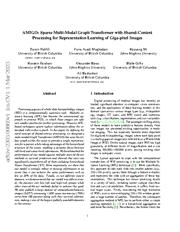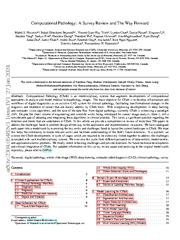A copy of this work was available on the public web and has been preserved in the Wayback Machine. The capture dates from 2022; you can also visit the original URL.
The file type is application/pdf.
Filters
Built to last? Reproducibility and Reusability of Deep Learning Algorithms in Computational Pathology
[article]
2022
medRxiv
pre-print
It is intended for both pathologists interested in deep learning, and researchers applying deep learning algorithms to computational pathology challenges. ...
AbstractRecent progress in computational pathology has been driven by deep learning. ...
This classification network was used to extract features in a pan-cancer fashion and, subsequently, to predict driver gene mutations. ...
doi:10.1101/2022.05.15.22275108
fatcat:wte5tu46gzf4pld25gbobqcjha
AMIGO: Sparse Multi-Modal Graph Transformer with Shared-Context Processing for Representation Learning of Giga-pixel Images
[article]
2023
arXiv
pre-print
Multiple instance learning (MIL) has become the conventional approach to process WSIs, in which these images are split into smaller patches for further processing. ...
We benchmarked the performance of our model against multiple state-of-the-art methods in survival prediction and showed that ours can significantly outperform all of them including hierarchical Vision ...
Related Work
Multiple Instance Learning in Histopathology Inspired by the bag-of-words idea, Zaheer et al. [46] and Brendel et al. ...
arXiv:2303.00865v2
fatcat:ldu663pmrvcclaga4zfa3ivhlu
Deep Learning Predicts Chromosomal Instability from Histopathology Images
2021
iScience
In this study, we sought to explore whether CIN status can be predicted using ubiquitously available hematoxylin and eosin histology through a deep learning-based model. ...
Chromosomal instability (CIN) is a hallmark of human cancer yet not readily testable for patients with cancer in routine clinical setting. ...
Classification and mutation prediction based on histopathology H&E images in liver cancer using deep learning. NPJ Precis. Oncol. 4, 14.Coudray, N., Moreira, A.L. ...
doi:10.1016/j.isci.2021.102394
pmid:33997679
pmcid:PMC8099498
fatcat:qut2qnyfifhpnehbpsn545zs6u
Artificial Intelligence to Decode Cancer Mechanism: Beyond Patient Stratification for Precision Oncology
2020
Frontiers in Pharmacology
Cancer is one of the most complex diseases affecting a range of organs with diverse disease progression mechanisms and the effectors ranging from gene-epigenetics to a wide array of metabolites. ...
Certain cancers, such as pancreatic and gastric cancers, are detected only after they have reached their advanced stages with frequent relapses. ...
Copy number, gene expression
Human
Yes
8 Integrative Oncogenomics Cancer Browser
(IntOGen)
Copy number, mutation, gene expression
Human
Yes
9 Mouse Retrovirus Tagged Cancer Gene
Database
Mutation ...
doi:10.3389/fphar.2020.01177
pmid:32903628
pmcid:PMC7438594
fatcat:u7mdynhnwfazbn6jhvcagorp2a
A Survey on Deep Learning for Precision Oncology
2022
Diagnostics
Deep learning has become the main method for precision oncology. ...
This paper summarizes the recent deep-learning approaches relevant to precision oncology and reviews over 150 articles within the last six years. ...
[8] proposed a DeepIMLH algorithm to identify gene mutations in lung cancer with hematoxylin-eosin (H&E) stained image to predict the mutated genes which are potential candidates for targeted drug therapy ...
doi:10.3390/diagnostics12061489
pmid:35741298
pmcid:PMC9222056
fatcat:2qgvdz4x7rejxkwgoascxk77ke
Deep Learning in Cancer Diagnosis and Prognosis Prediction: A Minireview on Challenges, Recent Trends, and Future Directions
2021
Computational and Mathematical Methods in Medicine
Deep learning (DL) is a branch of machine learning and artificial intelligence that has been applied to many areas in different domains such as health care and drug design. ...
Reduction of costs associated with sequencing systems offers a myriad of opportunities for building precise models for cancer diagnosis and prognosis prediction. ...
Transfer learning and multiple instance learning were combined for the classification of patch features. ...
doi:10.1155/2021/9025470
pmid:34754327
pmcid:PMC8572604
fatcat:wgpostjgsfeijazpyguobcrx4i
Molecular subtyping of colorectal cancer: Recent progress, new challenges and emerging opportunities
2018
Seminars in Cancer Biology
Along the "adenoma-carcinoma" sequence, mutations in several key genes such as KRAS and TP53 have demonstrated prognostic and predictive values. ...
For instance, MSI was shown to be associated with better prognosis and reduced metastasis [23] . ...
Recent advances in the machine learning community have shown a greater promise for applying deep learning for improved cancer classification. ...
doi:10.1016/j.semcancer.2018.05.002
pmid:29775690
pmcid:PMC6240404
fatcat:jtfffdfoznenfmigdydgekqxby
Deep Biological Pathway Informed Pathology-Genomic Multimodal Survival Prediction
[article]
2023
arXiv
pre-print
We propose PONET- a novel biological pathway-informed pathology-genomic deep model that integrates pathological images and genomic data not only to improve survival prediction but also to identify genes ...
The proposed method establishes insight into how to train biologically informed deep networks on multimodal biomedical data which will have general applicability for understanding diseases and predicting ...
WSIs exhibit enormous heterogeneity and most approaches adopt a two-stage multiple instance learning-based (MIL) approach for the representation learning of WSIs. ...
arXiv:2301.02383v1
fatcat:53es5pxxfbh77oue3koxk75e6m
Applications of Support Vector Machine (SVM) Learning in Cancer Genomics
2018
Cancer Genomics & Proteomics
Machine learning with maximization (support) of separating margin (vector), called support vector machine (SVM) learning, is a powerful classification tool that has been used for cancer genomic classification ...
to the discovery of new biomarkers, new drug targets, and a better understanding of cancer driver genes. ...
Acknowledgements This study has been supported by University of Manitoba Faculty of Science Interdisciplinary/New Directions Research Collaboration Initiation Grant, and partially by the Canadian Breast Cancer ...
doi:10.21873/cgp.20063
pmid:29275361
pmcid:PMC5822181
fatcat:o6l764hssnh2nbu4fm6b52f3mi
Histo-Genomic Knowledge Distillation For Cancer Prognosis From Histopathology Whole Slide Images
[article]
2024
arXiv
pre-print
Compared with traditional knowledge distillation methods (i.e., teacher-student architecture) in other tasks, our end-to-end model is superior in terms of training efficiency and learning cross-modal interactions ...
genomic perspectives to improve cancer prognosis. ...
Building on previous studies [4, 6, 37] , we employ the weakly supervised multiple-instance learning (MIL) strategy [31] , through which each WSI can be formulated as multiple instances assigned with ...
arXiv:2403.10040v1
fatcat:ugqwzz4pf5fyxoc35dx76hdotm
Computational Pathology: A Survey Review and The Way Forward
[article]
2024
arXiv
pre-print
With evergrowing developments in deep learning and computer vision algorithms, and the ease of the data flow from digital pathology, currently CPath is witnessing a paradigm shift. ...
Computational Pathology CPath is an interdisciplinary science that augments developments of computational approaches to analyze and model medical histopathology images. ...
the 10 most commonly mutated genes in adenocarcinoma. ...
arXiv:2304.05482v3
fatcat:orhl2kemibcwrevxew4fygv4pq
Deep learning-based cross-classifications reveal conserved spatial behaviors within tumor histological images
2020
Nature Communications
Breast cancers, bladder cancers, and uterine cancers have spatial patterns that are particularly easy to detect, suggesting these cancers can be canonical types for image analysis. ...
Patterns for TP53 mutations can also be detected, with WSI self- and cross-tissue AUCs ranging from 0.65-0.80. ...
Further, their models were able to predict mutations in ten genes in LUAD with AUCs 0.64-0.86, and subsequently mutations in BRAF (AUC ~0.75) or NRAS (AUC ~0.77) melanomas 20 . ...
doi:10.1038/s41467-020-20030-5
pmid:33311458
pmcid:PMC7733499
fatcat:zz6d2ykarncjrats6vbyjcedmi
Machine learning analysis of TCGA cancer data
2021
PeerJ Computer Science
In recent years, machine learning (ML) researchers have changed their focus towards biological problems that are difficult to analyse with standard approaches. ...
We also observe the rise in the use of deep artificial neural networks. It is worth emphasizing, the increase of integrative models of multi-omic data analysis. ...
For instance, sobreexpression of driver genes, methylation status or mutation types. ...
doi:10.7717/peerj-cs.584
pmid:34322589
pmcid:PMC8293929
fatcat:rpqlnnmujbhaxhqota5oz2gtcu
Cancer Type Classification in Liquid Biopsies Based on Sparse Mutational Profiles Enabled through Data Augmentation and Integration
2021
Life
Machine learning approaches have been proposed to classify the cell of origin based on somatic mutation profiles from solid biopsies. ...
Liquid biopsies are promising alternatives but their somatic mutation profile is sparse and current machine learning models fail to perform in this setting. ...
lower in patients with cancer types such as glioma, medulloblastoma, bladder, renal and gastroesophageal cancer [10] . ...
doi:10.3390/life12010001
pmid:35054395
pmcid:PMC8780455
fatcat:6azjv4is3nb77jgi2xlvod6ajq
Ontologies and Knowledge Graphs in Oncology Research
2022
Cancers
In total, our review encompasses 141 published works, which we categorized under 14 hierarchical categories according to their usage of ontologies and knowledge graphs. ...
Ontologies enable data accessibility, interoperability and integration, support data analysis, facilitate data interpretation and data mining, and more recently, with the emergence of the knowledge graph ...
building block of the P4 medicine vision (preventative, predictive, personalized and participatory). ...
doi:10.3390/cancers14081906
pmid:35454813
pmcid:PMC9029532
fatcat:t6erzohmvnextkix4infnk7kza
« Previous
Showing results 1 — 15 out of 230 results















